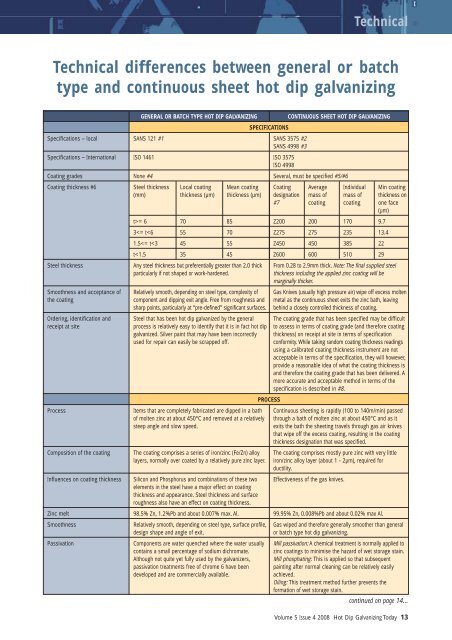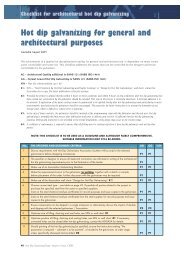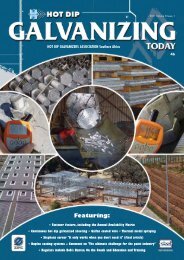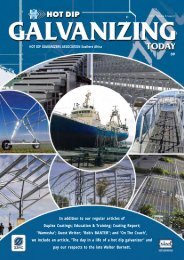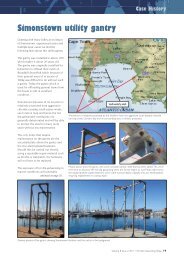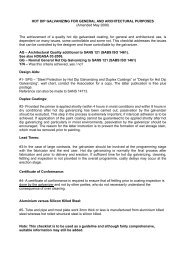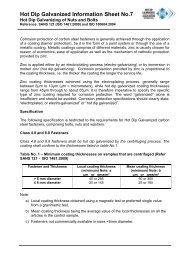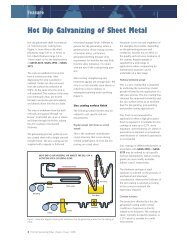Technical differences between general or batch type and ... - hdgasa
Technical differences between general or batch type and ... - hdgasa
Technical differences between general or batch type and ... - hdgasa
You also want an ePaper? Increase the reach of your titles
YUMPU automatically turns print PDFs into web optimized ePapers that Google loves.
<strong>Technical</strong><strong>Technical</strong> <strong>differences</strong> <strong>between</strong> <strong>general</strong> <strong>or</strong> <strong>batch</strong><strong>type</strong> <strong>and</strong> continuous sheet hot dip galvanizingGENERAL OR BATCH TYPE HOT DIP GALVANIZINGSPECIFICATIONSSpecifications – local SANS 121 #1 SANS 3575 #2SANS 4998 #3Specifications – International ISO 1461 ISO 3575ISO 4998CONTINUOUS SHEET HOT DIP GALVANIZINGCoating grades None #4 Several, must be specified #5/#6Coating thickness #6 Steel thickness Local coating Mean coating Coating Average Individual Min coating(mm) thickness (µm) thickness (µm) designation mass of mass of thickness on#7 coating coating one face(µm)t>= 6 70 85 Z200 200 170 9.73
<strong>Technical</strong>GENERAL OR BATCH TYPE HOT DIP GALVANIZINGPROCESS continuedCONTINUOUS SHEET HOT DIP GALVANIZINGTesting adhesion Testing of adhesion is not necessary in acc<strong>or</strong>dance with In <strong>or</strong>der to test the adhesion of a coating, a bend test <strong>and</strong>SANS 121. impact cupping test is conducted. See #9.DURABILITYC<strong>or</strong>rosion categ<strong>or</strong>ies C1 to C5M The c<strong>or</strong>rosion of a zinc coating <strong>or</strong> a duplex coating system (hot dip galvanizing <strong>and</strong> an appropriate paint system)(ISO 9223)varies depending on the atmosphere the coating is subjected to, see table #10 below extracted from ISO 9223, f<strong>or</strong> aperf<strong>or</strong>mance comparison <strong>between</strong> <strong>general</strong> <strong>and</strong> continuously hot dip galvanized sheeting.Enhanced c<strong>or</strong>rosion protection Iron/zinc alloy layers which make up <strong>between</strong> 50 <strong>and</strong> 85% Limited iron/zinc alloy layers due to process speed <strong>and</strong>of the coating provide up to 30% better c<strong>or</strong>rosion requirements f<strong>or</strong> final product ductility.protection than pure zinc.Cathodic protection at edges Zinc by its nature because of its position in the galvanic series of metals will sacrifice itself in preference to carbon steel.Cathodic protection is relative to moisture content, coating thickness <strong>and</strong> the amount of zinc present at the uncoated area.Effectiveness of cathodic M<strong>or</strong>e effective due to greater coating thickness <strong>and</strong> an M<strong>or</strong>e effective on thin gauges <strong>and</strong> thick coatings.protection intact coating at all edges. Less effective on thick gauge <strong>and</strong> thin coatings,particularly along cut exposed edges.Wet st<strong>or</strong>age stainWet st<strong>or</strong>age stain is a white voluminous deposit (zinc hydroxide) that is f<strong>or</strong>med on freshly hot dip galvanized surfaceswhich are in close contact in the presence of moisture. Freshly galvanized coatings react with the environment untilsuch time as the cause is removed <strong>and</strong> a stable zinc carbonate film is f<strong>or</strong>med on the coating surface. See #11Effect of wet st<strong>or</strong>age stain The presence of wet st<strong>or</strong>age staining will rarely have a The presence of wet st<strong>or</strong>age stain, in <strong>between</strong> closelymarked influence on a thick <strong>general</strong> hot dip galvanized nestled sheeting, will if not addressed early enough, leadcoating.to premature c<strong>or</strong>rosion of the zinc layer.Abrasion resistancePure zinc is a soft metal, even though it is harder than most <strong>or</strong>ganic coating materials. The iron/zinc alloys produced in<strong>batch</strong> <strong>or</strong> <strong>general</strong> hot dip galvanizing are however, very hard. In fact they are harder than <strong>or</strong>dinary structural steel.Superi<strong>or</strong> abrasion resistance The iron/zinc alloys provide superi<strong>or</strong> abrasion resistance. Less abrasion resistant than <strong>general</strong> hot dip galvanizingbut better than most <strong>or</strong>ganic <strong>or</strong> paint coatings.PRODUCTSAppearance Depending on steel <strong>type</strong>, coating appearance can vary Different appearances ranging from a spangle coating,from a spangle finish to a silvery <strong>or</strong> matt <strong>or</strong> even dark minimised spangle coating, iron/zinc alloy coating to amatt grey finish. differential coating are offered. See #12.Can appearance be altered? Yes, the addition of a Zn/Ni/Al alloy can improve coating See above.appearance.Ductility Not ductile, items must be completely fabricated bef<strong>or</strong>e Ductile f<strong>or</strong> subsequent profiling, as Fe/Zn alloy layercoating, <strong>general</strong>ly excessive bending will cause cracking almost non-existent.of the Fe/Zn alloy layer.Component size limitations Most fabricated steel items can be hot dip galvanized, Coils of sheeting, up to 1.5m wide, <strong>between</strong> 0.3 to 3.0mmprovided they can fit into the respective galvanizing bath thick <strong>and</strong> specified lengths.sizes. #13Coating repairsSite alterations <strong>and</strong> coating damage should be appropriately repaired. See #14. If not repaired, the uncoated area willsuffer discolouration <strong>and</strong> eventually localised c<strong>or</strong>rosion but c<strong>or</strong>rosion creep is impossible while zinc is present.Are coating repairs allowable in Yes, at the galvanizer <strong>or</strong> at site, provided that an individual No mention regarding coating repair is made in eitherterms of the st<strong>and</strong>ard? repair is no greater than 10cm 2 <strong>and</strong> the combined repair specification but if that is required, the same method ofarea on one component is not be greater than 0.5% of the coating repair would be applicable.surface area.F<strong>or</strong> enhanced c<strong>or</strong>rosion protection Combining a hot dip galvanized coating with an appropriate paint coating system, results in a synergistic effect, whereby<strong>or</strong> individual specification the sum of the individual coatings, can be increased by <strong>between</strong> 1.3 to 2.7 times the individual coating lives (dependingrequirements including a colour, on the specific environment at h<strong>and</strong>).hot dip galvanizing can be duplexcoated by painting with an Specify the use of the Association’s Code of Practice f<strong>or</strong> Specify “Chromaprep” – Fact<strong>or</strong>y primed coated hot dipappropriate paint system. Preparation, HDGASA 01-1990. galvanized sheeting, ready f<strong>or</strong> top coating.Specification f<strong>or</strong> the Perf<strong>or</strong>mance Requirements of Specify “Chromadek” <strong>or</strong> “Chromadek Plus” – Fact<strong>or</strong>yCoating Systems. HDGASA 02-1990.painted top coats.Engineering Specification, HDGASA 03-2006.Discuss with the Association <strong>and</strong>/<strong>or</strong> paint supplier.Preferably use galvanizer with in house industrial paintingfacilities.KINDLY REFER TO OUR WEBSITE AT WWW.HDGASA.ORG.ZA FOR NOTES 1 - 1114 Hot Dip Galvanizing Today Volume 5 Issue 4 2008


